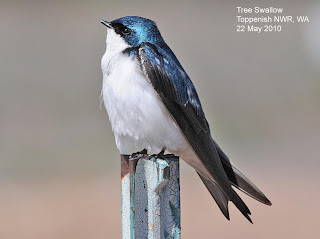This isn't Capistrano, but our swallows are on their way
back from their wintering grounds. The first to come are Tree Swallows (Tachycineta bicolor), which winter in
southern US and Mexico. They probably winter the farthest north because they
are programmed to migrate so early. In fact, a very few birds sometimes winter
as far north as Ridgefield National Wildlife Refuge in southwestern Washington.
Tree Swallows are cavity nesters. But they can't excavate
their own cavities like a woodpecker can, so they depend on natural cavities,
old woodpecker holes, and nest boxes that we put up for them. They like to nest
over water when they can, as predators that can climb trees to prey upon
swallow eggs and young don't inhabit flooded wetlands.
Thus nesting cavities for them are quite limited, and there
is fierce competition for them among swallow pairs. The earlier a male swallow
returns to its breeding grounds, the more likely it will find an unoccupied
cavity. Once a cavity is occupied, it's an uphill battle for the next bird that
shows up to try to take it over, and so first come, first served.
Thus our Tree Swallows start trickling back to western
Washington by late February, and the trickle becomes a river by the beginning
of April. By that time, pretty much all available cavities are taken. Of course
many of these birds continue on north, all the way to Alaska.
This surprisingly early arrival, well before our real
spring, comes with a downside. The weather can be wretched at this time of
year, cold and windy and rainy. Swallows are aerial insectivores, and their
prey can be very hard to come by under such conditions. There is no doubt that
in an especially bad spring, some of the birds succumb to starvation. There is
no point in trying to raise a brood of young until conditions get better, so
they don't attempt that until considerably later, some time in April or May.
Male and female Tree Swallows look the same, beautifully
iridescent blue above and snow-white below, but with an interesting caveat.
First-year males look just like older birds, but first-year females are
recognizably different, dull brown on the back. There are scarcely any birds in
the World with a unique first-year female, but the Tree Swallow is one. The
adaptive significance of this first-year plumage is poorly understood.
Dennis Paulson




2 comments:
"...a very few birds sometimes winter as far north as Ridgefield National Wildlife Refuge in southwestern Washington."
We have them in a backyard box in Washougal, WA this year!
We have these beautiful little birds in several of our backyard bird houses. We simply love them!!!
Post a Comment